|
I have been experimenting with the outward rotation of the hips and how that drastically changes the relationship between the legs and the pelvis. When the hips are "straight" with the feet pointing forward, a forward fold largely lengthens the hamstrings and a backward bend lengthens the quadriceps. But when we rotate the hips outward like we do in Pigeon or Lotus, the relationship changes. 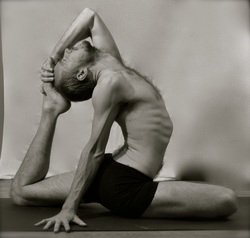 Pigeon Pigeon Think about Pigeon. A forward fold targets a more complex set of mobilizing and stabilizing muscles on the sides of the hip and lower back. It is not so simple and clear cut as a stretch of the hamstrings.  And Spider. Straightening the hips targets a very tight and sensitive group of muscles in the groin. This is similar to what we target in Half Lotus Tree, Short Man and Mountain Poses.
0 Comments
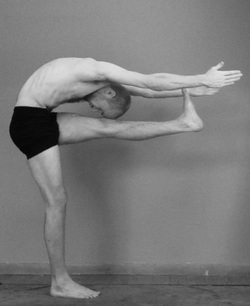 I love to find new postures that build on the foundational ones. They keep me on my toes (figuratively) and help me understand my body. Here are two postures that I have added to my practice recently. Standing Head to Knee with Extended Arms is a variation of the foundational Standing Head to Knee posture. With the arms extended forward instead of grasping the foot, the energy in the posture shifts dramatically. Effort goes to holding the leg up with the thigh, abs and psoas instead of relying on the arms. When I release my hands, the energy in the posture skyrockets. 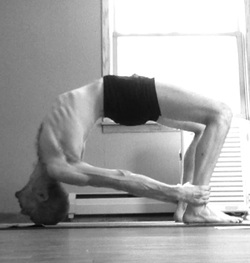 Another posture that I just learned is this Bridge variation on the head. (Be careful with this one.) The weight of the body goes into the neck, and the chest stretches outward. This seems good for building neck strength and balance, and it is a nice transition posture between Bridge on the shoulders and Wheel. "These Indian contributions...will become public property. No patents will ever be taken. The spirit of our national culture demands that we should forever be free from the desecration of utilizing knowledge only for personal gain."
From 'Autobiography of a Yogi' by Paramahansa Yogananda. 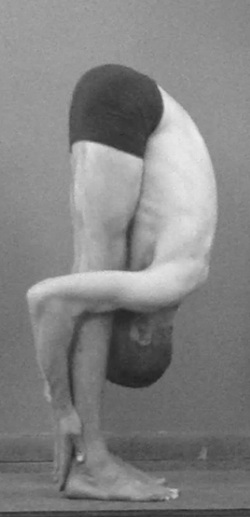 In Hands To Feet Pose (Padahastasana) we bend the upper body down to lay flat against the thighs and legs, stretching the back of the legs, especially the hamstrings. Ideally, this is not a back stretch. The pelvis should tilt forward as much as possible, keeping the back nearly straight and moving the stretch into the upper hamstrings. (In the picture to the left, you'll notice that due to the tilt in my pelvis, there is gentle rounding in the back. Over time, this rounding should decrease as my hamstrings lengthen and the pelvis is free to tilt forward/down more, so the sit-bones will go higher and the back will be straighter.) In Bikram's class, we are instructed to place our fingers underneath our heels and shift our body weight forward. When we shift our weight forward, the backside of our legs engage - the calves, hamstrings and glutes - to keep us from falling forward. These are the very muscles that we are trying to stretch, so we should relax them as much as possible. Try this: don't put your fingers underneath your heels. Place your hands around the back of your ankles or heels, but leave your feet flat on the ground. Then, instead of shifting your weight forward, shift it slowly backward. See if your hamstrings and calves don't relax, allowing you to stretch them. Excerpted from an article by Carol Horton, Ph.D. Read the whole article here.
We’ve heard a lot about “yoga scandals” in the past several years: John Friend, Kausthub Desikachar, and most recently, Bikram Choudhury. Given that five separate lawsuits accusing Bikram of “rape, harassment, assault, discrimination and false imprisonment” have been filed, however, simply labeling it a “scandal” seems insultingly misleading. After all, we’re not talking about a prudish moral panic here: these are serious criminal charges. There was an enormous amount of outraged discussion and contentious debate over the “Anusara scandal” back in 2012. There has been very little public discussion of the Bikram case, however, at least in the formerly fermenting yoga blogosphere. It’s a curious situation, as the pending charges against Bikram are much more serious than the parallel set against Friend. One might imagine that the level of public outcry would increase in tandem with the gravity of the allegations being made. In fact, however, precisely the opposite is true. Read the rest of the article here. "I'd believed that in order to do what I was afraid of, I had to get rid of the fear first, but that turned out to be only an idea, not the truth. You have to do something two hundred times before the fear will disperse. Are you still afraid of something? Just do it again. Do it again. Do it again."
From 'Fierce Medicine' by Ana T. Forrest Yesterday, Ida taught the Core 40 at our home studio in Madison, Inner Fire Yoga. The class was for teachers and regular practitioners only, who also happen to be some of our closest friends. Basically it was to show the Core 40 sequence as a progression from Bikram's 26 - to share this knowledge and these postures we have been practicing for 8 months and that we learned firsthand from Tony Sanchez in December.
Doing the Core 40 class in my home studio, in the same room where I have practiced "the 26" hundreds of times, and where I have cleaned the floors and mirrors hundreds of times, was a beautiful experience. Ida was teaching the class, I was simply in the front trying to demonstrate the new postures as well as possible, but I felt like we were giving back to our community. We have something unique to offer, and we offer it gladly. Those who took the class were excited by the new postures and the more advanced style of the teaching - less dialogue, more stillness, more advanced grips and alignments. It is a bit of a relief for all of us who love the more traditional style of hatha yoga, where each pose is separate from the next, interspersed with stillness. We have been aching for some new postures beyond the 26 and some more advanced instruction. From my teacher Tony Sanchez.
Before the mind can be purified the body must go through a process of absolute purification. The original goal in Hatha yoga was to clear the body of the different impurities that afflicts it. The Nadis should be clear pathways for energy to circulate unobstructed. Ideally this energy must move freely like wave frequencies throughout these channels within the body including the brain. Hatha yoga has been considered preliminary practice for Tantra, Raja, Kundalini and Kriya yoga. The main objective of Hatha Yoga is to create perfect balance between all the interacting activities and processes of the body, mind and energy. We also know Hatha Yoga has wonderful physical and mental health related benefits. In the present moment, I feel, is where we can be most effective to help the world community. Lets consider the poor state of health the world is in at this crucial moment and do something about it. |
This journal honors my ongoing experience with the practice, study and teaching of yoga.
My FavoritesPopular Posts1) Sridaiva Yoga: Good Intention But Imbalanced
2) Understanding Chair Posture 2) Why I Don't Use Sanskrit or Say Namaste 3) The Meaningless Drudgery of Physical Yoga 5) Beyond Bikram: Why This Is a Great Time For Ghosh Yoga Categories
All
Archives
November 2017
|

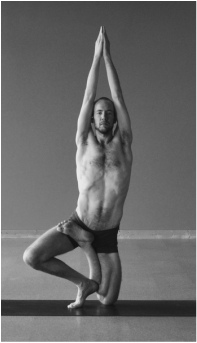
 RSS Feed
RSS Feed